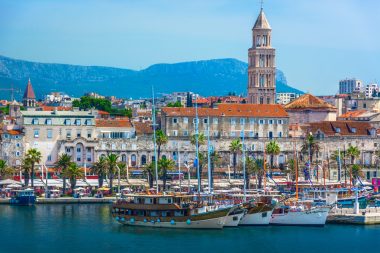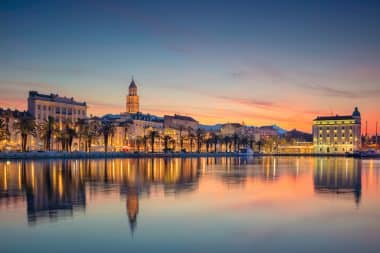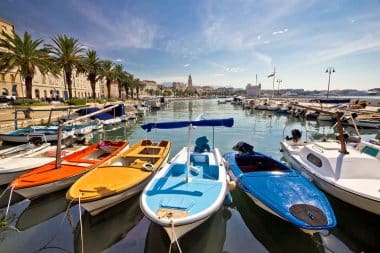The fact that Croatia with its beautiful landscape, nature parks, sea and islands is worth a visit probably doesn’t need to be explained to any holidaymaker today. While most tourists enjoy these treasures or spend a beach holiday on the coasts, it is also worth taking a look at the country’s cities.
There’s Dubrovnik , of course, with its medieval fortress and recent notoriety thanks to Game of Thrones. A little less noticed, but linked to an even more interesting historical and cultural history, is Split. The heart of Croatia invites holidaymakers to explore and combines ancient charm with modern life in Croatia. For many visitors to Croatia, Split is also an excellent starting point to explore Croatia and its islands with a yacht charter .
Historic town in the middle of Dalmatia

Split is said to have been founded over 1700 years ago and has since experienced a lot in the eventful history of the Balkans and Europe in general. Next to Zagreb , it is the largest city in Croatia with around 200,000 inhabitants. Split has become one of the most popular places to live, especially among young people, which is also evident on the streets and not least in the city’s active nightlife. Yet it gains its charm precisely from this point: modern Croatia meets the many testimonies of the country’s long history that can be seen everywhere in the city. Modern shops blend in perfectly next to old palaces and walls, giving the city a very special flair.
The foundation of the city dates back to a Roman emperor who wanted to have a palace built for his retirement in the nature of Dalmatia. From here begins the long history that has seen many rulers come and go. Naples, Venice, Bosnia, Austria-Hungary – many empires and rulers have claimed their possession over the city and until Yugoslavia and today’s Croatia took shape, a wide variety of cultures shaped the city. This is still visible today, because the city is multicultural and thus adapts to the young spirit that is so typical of Split.
What is a “must see” during your visit to Split?

What immediately catches the eye when walking through the streets – in addition to the many old buildings – is the multitude of churches, monasteries and other sacred buildings in the city. The church has always played a special role in the history of the city and the former Dominus of Split even went down in history as a martyr. The Cathedral of St. Dominus with its campanile is therefore also one of the most outstanding buildings in the city and can be seen from almost every corner. But the many churches and other buildings of the church period are also worth a visit. In addition, the most diverse faiths meet in the city – another peculiarity of cosmopolitan Croatia and the Balkans in general.
The real figurehead, however, is the Diocletian’s Palace. It is the palace that the Roman emperor had built as the nucleus for today’s Split. Admittedly, it may no longer have its former glory, but it is still an important testimony to history and the most important tourist attraction in the city. From here you can also reach the four magical gates, which are closely linked to the history of the palace. So this is one of the most important sights and offers an interesting insight into how the city was formed around the palace.

Of course, there are also many other old buildings. But if you want to experience a little of Croatia’s special nature, there are just as many opportunities around the city. The wonderful beaches that are located in the immediate vicinity of the city are just one example of this. The mountains of Dalmatia and the special nature of the region also invite you to go on excursions. Hotels and providers in the city also offer special tours for this purpose.
Experience Split by day and night
Of course, a visit to the city wouldn’t be complete without experiencing a little culture. Museums and galleries invite you to discover a little more of Croatia and understand why the country has undergone such an interesting transformation over the centuries. But you should especially enjoy the many good restaurants. Croatian cuisine is becoming a real trend in Europe and has a lot to offer for gourmets and friends of hearty cuisine. If you then also immerse yourself in the nightlife and sit down in one of the bars or visit a club, then you have finally arrived in Split.
Holidays in Split: The best tips
Introduction
Split, the second largest city in Croatia, is a popular tourist destination on the Adriatic coast. Known for the impressive Diocletian’s Palace, clear waters, and lively Old Town, Split offers a perfect blend of culture, history, and relaxation. Here are the best tips for an unforgettable vacation in Split.
Journey
- Airport: Split Airport (SPU), about 24 km west of the city centre. Regular bus and taxi services take travelers to the city center.
- Train: Split’s main train station is right next to the port and bus station, and offers good connections to other cities.
- Car: Good road connections, especially via the A1 motorway, which connects Split with Zagreb and other cities.
Best time to visit
- Spring (April to June): Pleasant temperatures and fewer tourists.
- Summer (July to August): Warm weather, ideal for beach holidays, but also the high season.
- Autumn (September to October): Pleasant weather and fewer tourists.
Activities and sights
- Diocletian’s Palace: One of the best-preserved Roman ruins in the world and a UNESCO World Heritage Site.
- Riva: The beautiful waterfront of Split, ideal for walks and cafes.
- Marjan Hill: A large city park with hiking trails, viewpoints, and historic churches.
- Beaches: Bacvice, Znjan, and Kasjuni are some of the most popular beaches in Split.
- Museums: The Archaeological Museum, the Maritime Museum and the Meštrović Gallery are worth seeing.
- Day Trips: Visit nearby islands such as Hvar, Brac, and Vis, or take a tour to the Krka Waterfalls.
Important telephone numbers
- Emergency: 112 (general emergency)
- Police: 192
- Fire brigade: 193
- Ambulance service: 194
- Tourist Information Split: +385 21 345 606
German Doctors
- Dr. Martin Rieger: Poljička cesta 39, +385 21 488 111
- Dr. Anna Müller: Kroz Smrdečac 45, +385 21 453 444
Important words with translation
- Hello – Bok
- Thank you – Hvala
- Please – Molim
- Yes – There
- No – Ne
- Sorry – Oprostite
- Where is…? – Gdje je…?
- How much does it cost…? – Koliko košta…?
- Emergency – Hitni slučaj
- Doctor – Liječnik
- Hospital – Bolnica
Holidays
- New Year’s Day: January 1
- Epiphany: January 6
- Easter Monday: variable (March/April)
- Labour Day: 1 May
- Victory Day and Homeland Gratitude: 5 August
- Assumption Day: 15 August
- Independence Day: October 8
- All Saints’ Day: November 1
- Christmas: December 25
- St. Stephen’s Day: December 26
Opening hours
- Shops: Usually Monday to Saturday from 8:00 a.m. to 8:00 p.m., Sunday often shorter opening hours.
- Supermarkets: Usually daily from 7:00 a.m. to 9:00 p.m.
- Restaurants: Lunch from 12:00 to 15:00, dinner from 18:00 to 23:00.
- Banks: Monday to Friday from 8:00 a.m. to 7:00 p.m., Saturday from 8:00 a.m. to 12:00 p.m.
NUDISM
- Nudist beaches: Split offers some official nudist beaches, including Kasjuni and some areas of the islands nearby.
Post / Stamps
- Post offices: In all major districts and towns. Main post office near the Riva. Opening hours: Monday to Friday from 8:00 a.m. to 7:00 p.m., Saturday from 8:00 a.m. to 1:00 p.m.
- Stamps: Available at the post office, kiosks and supermarkets.
- Costs for letters and postcards to Germany: Standard letter up to 50g: approx. 2 EUR; Postcard: approx. 1.50 EUR
Safety
- Crime: Split is considered safe. Observe common precautions as in any tourist city, especially against pickpockets in busy areas and markets.
- Emergency number: 112
Current
- Voltage: 230 volts
- Sockets: Type C and F (as in Germany)
Tip
- Restaurants: 5-10% of the bill amount, often included in the bill.
- Taxis: Round up the amount
- Hotels: 1-2 euros per day for cleaning staff
Customs
- Allowances within the EU: No customs restrictions on personal belongings.
- Alcohol: Maximum 10 liters of spirits, 20 liters of alcoholic beverages with less than 22%, 90 liters of wine, 110 liters of beer.
- Tobacco: 800 cigarettes, 400 cigarillos, 200 cigars, 1 kg of tobacco.


